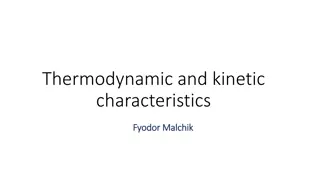Introduction to Thermodynamics: Laws, Concepts, and Applications
Thermodynamics is the study of energy and its transformations within systems. This article delves into the laws of thermodynamics, defining key quantities like temperature and entropy. It explains the importance of thermodynamic systems, boundaries, and surroundings, highlighting closed, open, and isolated systems. Gain insights into the foundational principles of thermodynamics and their real-world implications.
Download Presentation

Please find below an Image/Link to download the presentation.
The content on the website is provided AS IS for your information and personal use only. It may not be sold, licensed, or shared on other websites without obtaining consent from the author.If you encounter any issues during the download, it is possible that the publisher has removed the file from their server.
You are allowed to download the files provided on this website for personal or commercial use, subject to the condition that they are used lawfully. All files are the property of their respective owners.
The content on the website is provided AS IS for your information and personal use only. It may not be sold, licensed, or shared on other websites without obtaining consent from the author.
E N D
Presentation Transcript
PHYSICS PHYSICS B.Sc Part I Dr. Rajesh Kumar Neogy Assistant Professor Dept. Of Physics M. L Arya College kasba
Laws of Thermodynamics Thermodynamics Thermodynamics is the study of the effe cts of work, heat, and energy on a system Thermodynamics is only concerned with macroscopic (large-scale) changes and obs ervations
Getting Started All of thermodynamics can be expressed in terms of four quantities (i) Temperature (T) (ii) Internal Energy (U) (iii) Entropy (S) (iv) Heat (Q) We will take up and discuss all these quantit ies as we progress through the lesson
Introduction According to British scient ist C. P. Snow, the three laws of thermo dynamics can be (humorously) summa rized as 1. You can t win 2. You can t even break even 3. You can t get out of the game
1.0 You cant win (1st law) The first law of thermodynamics is a n extension of the law of conservation of energy The change in internal energy of a sy stem is equal to the heat added to the system minus the work done by the sy stem U = Q - W
Definitions In our study of thermodynamics, we will choose a small part of the universe to which we will apply the laws of thermodynamics. We call this subset a SYSTEM. The thermodynamic system is analogous to the free body diagram to which we apply th e laws of mechanics, (i.e. Newton s Laws of Motion). The system is a macroscopically identifiable collection of matter on which we focus our attention (eg: the water kettle or the aircraft engine).
The rest of the universe outside the system close enough to the system to have some p erceptible effect on the system is called the surroundings. The surfaces which separates the system from the surroundings are called the boundari es as shown in fig below (eg: walls of the kettle, the housing of the engine). Closed system - in which no mass is permitted to cross the system boundary i.e. we wo uld always consider a system of constant mass. We do permit heat and work to enter or leave but not mass. Open system- in which we permit mass to cross the system boundary in either directio n (from the system to surroundings or vice versa). In analysing open systems, we typica lly look at a specified region of space, and observe what happens at the boundaries of t hat region. Isolated System - in which there is no interaction between system and the surroundin gs. It is of fixed mass and energy, and hence there is no mass and energy transfer acr oss the system boundary.
Zeroth Law Of Thermodynamics (Contd) Two systems are said to be equal in temperature, when there is no change in their respe ctive observable properties when they are brought together. In other words, when two s ystems are at the same temperature they are in thermal equilibrium (They will not excha nge heat). Explanation of Zeroth Law Let us say T A,TBand TCare the temperatures of A,B and C respectively. A and c are in thermal equilibrium. Ta= tc B and C are in thermal equilibrium. Tb= tc Consequence of of 0 th law A and B will also be in thermal equilibrium TA= TB Looks very logical All temperature measurements are based on this LAW.























